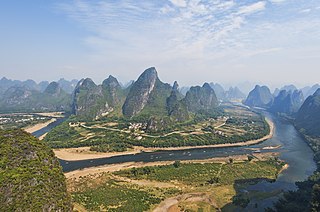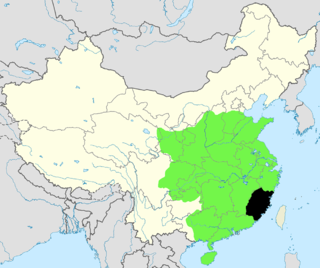
Guangdong, alternately romanized as Canton Province or Kwangtung, is a coastal province in South China on the north shore of the South China Sea. The capital of the province is Guangzhou. With a population of 126.01 million across a total area of about 179,800 km2 (69,400 sq mi), Guangdong is the most populous province of China and the 15th-largest by area as well as the second-most populous country subdivision in the world. Its economy is larger than that of any other province in the nation and the 4th largest sub-national economy in the world with GDP of 1.66 trillion USD in 2019. The Pearl River Delta Economic Zone, a Chinese megalopolis, is a core for high technology, manufacturing and foreign trade. Located in this zone are two of the four top Chinese cities and the top two Chinese prefecture-level cities by GDP; Guangzhou, the capital of the province, and Shenzhen, the first special economic zone in the country. These two are among the most populous and important cities in China, and have now become two of the world's most populous megacities.

The Zhuang are a Tai-speaking ethnic group who mostly live in the Guangxi Zhuang Autonomous Region in Southern China. Some also live in the Yunnan, Guangdong, Guizhou and Hunan provinces. They form one of the 56 ethnic groups officially recognized by the People's Republic of China. With the Buyi, Tay–Nùng and other Northern Tai speakers, they are sometimes known as the Rau or Rao people. Their population, estimated at 18 million people, makes them the largest minority in China, followed by Hui and Manchu.
The Song dynasty of China was an imperial dynasty that ruled most of China proper and southern China from the middle of the 10th century into the last quarter of the 13th century. The dynasty was established by Emperor Taizu of Song with his usurpation of the throne of Later Zhou, ending the Five Dynasties and Ten Kingdoms period.
The Buyang people are an officially unrecognized Kra ethnic group living in Wenshan Prefecture, Yunnan and Napo County, Guangxi in China. They are closely related to the Laha, Qabiao, Gelao, and Lachi. The Buyang language is spoken, although many Buyang are now shifting to Zhuang and Southwestern Mandarin. In Yunnan, the Buyang are classified by the Chinese government as Zhuang, while they are classified as Yao in Guangxi.
Baizhou or Bai Prefecture was a zhou (prefecture) in imperial China in modern southern Guangxi, China. It existed intermittently from 623 to 1136, and between 742 and 758 it was known as Nanchang Commandery.

Guangxi, officially the Guangxi Zhuang Autonomous Region (GZAR), is an autonomous region of the People's Republic of China, located in South China and bordering Vietnam and the Gulf of Tonkin. Formerly a province, Guangxi became an autonomous region in 1958. Its current capital is Nanning.
Hebei Circuit or Hebei Province was one of the major circuits during the Tang dynasty, Five Dynasties period, and early Song dynasty. During the Tang dynasty it was known as Hebei Dao (河北道), and during the Song dynasty Hebei Lu (河北路), but both dao and lu can be translated as "circuit". In 1042 it was divided into two circuits: Hebei East Circuit and Hebei West Circuit.
Jingdong Circuit or Jingdong Province was one of the major circuits during the Song dynasty. In 1072 it was divided into two circuits: Jingdong East Circuit and Jingdong West Circuit.
Lizhou Circuit or Lizhou Province was one of the major circuits during the Song dynasty. It was split from Xichuan Circuit in 1001.

Liangzhe Circuit (997–1160s) was one of the major circuits during the Song dynasty (960–1279). Its administrative area corresponds roughly to modern Zhejiang, Shanghai, and southern Jiangsu. The fertile Yangtze River Delta lay within Liangzhe Circuit, as did Lake Tai. Liangzhe was the wealthiest circuit in Song.
Huainan Circuit or Huainan Province was one of the major circuits during the Tang dynasty, Five Dynasties period, and early Song dynasty. Huainan was also the name of Wu, whose territorial claims was nearly identical to the circuit. In 1072 during the Song dynasty it was divided into 2 circuits: Huainan East Circuit and Huainan West Circuit.
Guangnan Circuit or Guangnan Province was a short-lived circuit during the early Song dynasty, corresponding to the former Southern Han territory after Southern Han was annexed by Song in 971. In 988, Guangnan Circuit was divided into Guangnan East Circuit and Guangnan West Circuit.
Jinghu Circuit or Jinghu Province was one of the major circuits during the Song dynasty from 985 and 998. In 998 it was divided into 2 circuits: Jinghu North Circuit and Jinghu South Circuit.

Fujian Circuit, also translated as Fujian Province, was one of the major circuits during the Tang and Song dynasties of imperial China. Its administrative area corresponds to roughly the modern Chinese province of Fujian.

Guangnan East Circuit or Guangnan East Province was one of the major circuits during the Song dynasty. Its administrative area corresponds to roughly the modern Chinese province of Guangdong.

Jinghu South Circuit or Jinghu South Province was one of the circuits during the Song dynasty. Its administrative area corresponds roughly to the modern province of Hunan.

Jinghu North Circuit or Jinghu North Province was one of the circuits during the Song dynasty. Its administrative area corresponds to roughly the modern province of Hunan.

The Song-Vietnamese War', or Kháng chiến chống Tống lần thứ nhất, 'First War against the Song', was a military conflict between the Lý dynasty of Đại Việt and the Song dynasty of China between 1075 and 1077. The war began in 1075 when King Lý Nhân Tông ordered a preemptive invasion upon the Song dynasty with more than 80,000 soldiers, where Đại Việt razed the city of Yongzhou to the ground after a forty-two day siege, defeating the Song. In response, 300,000 of Song troops crossed the border the following year. By 1077, the Song nearly reached Đại Việt's capital Thăng Long before being halted by general Lý Thường Kiệt at Như Nguyệt River in modern-day Bắc Ninh Province. After long battling at the river with high casualties on both sides, Lý general Lý Thường Kiệt offered peace and the Song commander Guo Kui agreed to withdraw his troops, ending the war.

Jiangzhe province (江浙行省) was a province of the Yuan dynasty established in 1276. It included the southern portion of Jiangsu south of the Yangtze River, Zhejiang, Fujian and part of northern Guangdong. With capital was initially at Yangzhou, but in 1297 it was moved to Hangzhou Lu.
Nong Minfu was a Tai-speaking Rau chieftain who ruled over an area in what is today's Sino-Vietnamese borderland. He could have been Nong Quanfu's father. He was probably the leader of a confederation of tribes.










